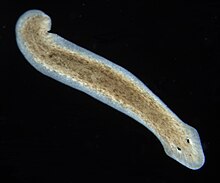
Back بلانريان Arabic Planarilər Azerbaijani Планарыі Byelorussian Planària Catalan Planarien German کرمهای جاودانه Persian Planaire (zoologie) French Plánárach Irish Halhatatlan féreg Hungarian Planaria ID
The article's lead section may need to be rewritten. The reason given is: it does not summarise the body. (December 2023) |
| Planarian | |
|---|---|

| |
| Dugesia subtentaculata, a dugesiid. | |
| Scientific classification | |
| Domain: | Eukaryota |
| Kingdom: | Animalia |
| Phylum: | Platyhelminthes |
| Subphylum: | Rhabditophora |
| Order: | Tricladida Lang, 1884 |
| Subdivisions[1] | |
| |
Planarians (triclads) are free-living flatworms of the class Turbellaria,[2][3] order Tricladida,[4] which includes hundreds of species, found in freshwater, marine, and terrestrial habitats.[5] Planarians are characterized by a three-branched intestine, including a single anterior and two posterior branches.[5] Their body is populated by adult stem cells called neoblasts, which planarians use for regenerating missing body parts.[6] Many species are able to regenerate any missing organ, which has made planarians a popular model in research of regeneration and stem cell biology.[7] The genome sequences of several species are available, as are tools for molecular biology analysis.[7][8]
The order Tricladida is split into three suborders, according to their phylogenetic relationships: Maricola, Cavernicola and Continenticola. Formerly, the Tricladida was split according to their habitat: Maricola (marine planarians); Paludicola (freshwater planarian); and Terricola (land planarians).[9]
Planarians move by beating cilia on the ventral dermis, allowing them to glide along on a film of mucus. Some also can move by undulations of the whole body by the contractions of muscles built into the body membrane.[10]
Triclads play an important role in watercourse ecosystems and are often very important as bio-indicators.[11]
- ^ Sluys, R.; Kawakatsu, M.; Riutort, M.; Baguñà, J. (2009). "A new higher classification of planarian flatworms (Platyhelminthes, Tricladida)". Journal of Natural History. 43 (29–30): 1763–1777. Bibcode:2009JNatH..43.1763S. doi:10.1080/00222930902741669. S2CID 85174457.
- ^ "Planarian (flatworm) – Britannica Online Encyclopedia". Encyclopædia Britannica, Inc. Retrieved 2010-05-01.
- ^ Campbell NA, Reece JB (2019). Biology. Benjamin Cummings. pp. 1230 pp. ISBN 978-0-8053-7146-8.
- ^ "Tricladida". Integrated Taxonomic Information System. Retrieved July 23, 2007.
- ^ a b Sluys, Ronald; Riutort, Marta (2018), Rink, Jochen C. (ed.), "Planarian Diversity and Phylogeny", Planarian Regeneration: Methods and Protocols, Methods in Molecular Biology, vol. 1774, New York, NY: Springer, pp. 1–56, doi:10.1007/978-1-4939-7802-1_1, ISBN 978-1-4939-7802-1, PMID 29916154, retrieved 2023-12-02pp 3., "Planarians (the popular name for the group as a whole), or triclad flatworms (the more scientific designation of the same group), are acoelomate bilaterians".
- ^ Vila-Farré, Miquel; Rozanski, Andrei; Ivanković, Mario; Cleland, James; Brand, Jeremias N.; Thalen, Felix; Grohme, Markus A.; von Kannen, Stephanie; Grosbusch, Alexandra L.; Vu, Hanh T.-K.; Prieto, Carlos E.; Carbayo, Fernando; Egger, Bernhard; Bleidorn, Christoph; Rasko, John E. J. (2023-10-19). "Evolutionary dynamics of whole-body regeneration across planarian flatworms". Nature Ecology & Evolution. 7 (12): 2108–2124. doi:10.1038/s41559-023-02221-7. ISSN 2397-334X. PMC 10697840. PMID 37857891. S2CID 264347538.
- ^ a b Newmark PA, Sánchez Alvarado A (March 2002). "Not your father's planarian: a classic model enters the era of functional genomics". Nature Reviews. Genetics. 3 (3): 210–9. doi:10.1038/nrg759. PMID 11972158. S2CID 28379017.
- ^ Rozanski, Andrei; Moon, HongKee; Brandl, Holger; Martín-Durán, José M; Grohme, Markus A; Hüttner, Katja; Bartscherer, Kerstin; Henry, Ian; Rink, Jochen C (2019-01-08). "PlanMine 3.0—improvements to a mineable resource of flatworm biology and biodiversity". Nucleic Acids Research. 47 (D1): D812–D820. doi:10.1093/nar/gky1070. ISSN 0305-1048. PMC 6324014. PMID 30496475.
- ^ Hallez P. (1892). Classification des Ticlades, Bulletin de la Société Zoologique de France.
- ^ Rompolas P, Patel-King RS, King SM (2009). Schmidtea mediterranea: a model system for analysis of motile cilia. Methods in Cell Biology. Vol. 93. pp. 81–98. doi:10.1016/S0091-679X(08)93004-1. ISBN 9780123813770. PMID 20409812.
- ^ Manenti R (2010). "– Effect of landscape features and water quality on Triclads inhabiting head waters: the example of Polycelis felina" (PDF). Revue Écologie Terre et Vie. 65 (2): 279–285. doi:10.3406/revec.2010.1533. hdl:2434/147984. S2CID 54499235.
© MMXXIII Rich X Search. We shall prevail. All rights reserved. Rich X Search